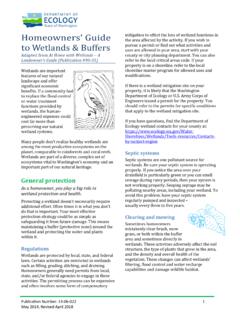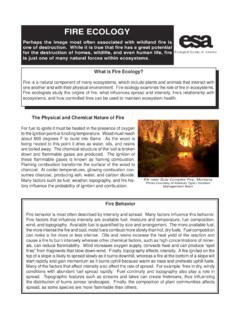Transcription of Pinus nigra - Forest
1 Pinus nigra Pinus nigra in Europe: distribution, habitat, usage and threats C. M. Enescu, D. de Rigo, G. Caudullo, A. Mauri, T. Houston Durrant are recognised: Pinus nigra subsp. salzmannii (Corsican pine), occurring in the east of the range from Morocco and Spain to Pinus nigra Arnold, known as European black pine or black pine, is a fast-growing conifer with a wide but fragmented South France and Corsica, and Pinus nigra subsp. nigra (Austrian distribution across Europe and Asia Minor, predominantly in mountain areas. It has also become naturalised in some pine), occurring in the west of the range from Austria and North- areas in North America.
2 It is subdivided into several distinct subspecies and its taxonomic status is still a subject of East and Central Italy through Balkans up to Turkey and Crimea debate among specialists. Black pine regenerates with difficulties after a fire event, particularly during periods with Peninsula. However, more than 100 Latin specific, varietal, and extreme droughts when the development of seedlings can become challenging. This is thought to trigger a reduction of formal names have been recorded by different authorities and its habitat in southern Europe; on the contrary in Central Europe the climate amelioration might generate an expansion.
3 There is no general consensus4, 20-22 . Black pine ( Pinus nigra Arnold) is a large evergreen conifer commonly reaching 30 m, but exceptionally it is capable Frequency of attaining heights up to 40 m1, 2 . Its bark is usually a dark < 25%. 25% - 50%. greyish brown to black (giving rise to its Latin name nigra ) 50% - 75%. and becomes deeply furrowed longitudinally on older trees3 . > 75%. Chorology On young individuals, the crown is conical, becoming umbrella- Native shaped on older trees4 . Needles are in pairs 8-15(19) cm long, 1-2 mm in diameter, straight or curved, and finely serrated1, 2.
4 They normally persist on the tree for 3-4 years (exceptionally up to 8)5 . Black pine is monoecious. Male catkins are yellow, while female inflorescences are reddish. Cones are sessile, 4-8(9) cm long, 2-4 cm wide and yellow-brown in colour1, 2. They ripen in the autumn of the second year, and open in the third year. Cones contain 30-40 seeds. The seeds are grey, 5-7 mm long, with a wing 19-26 mm long4 . It is a long-lived species, with a life span of over 400 years6 . One specimen in Germany (the Vier-Br der- Baum from its four main stems) is reported to be over 1 000.
5 Years old and with a girth over 7 m7. Distribution Map 1: Plot distribution and simplified chorology map for Pinus nigra . Frequency of Pinus nigra occurrences within the field observations as The past distribution of black pine in Europe is difficult reported by the National Forest Inventories. The chorology of the native to reconstruct. This because past occurrences based on both spatial range for P. nigra is derived after EUFORGEN48 . pollen and charcoal (widely used to reconstruct past species distribution) cannot be easily recognised at the species level8.
6 Spread conifer species in the Balkans and Asia Minor. Its widest However, more localized studies mainly based on macrofossils distribution worldwide is in Turkey, with more than million suggest that large populations of black pine were already present hectares12 . Outside Europe, it was also introduced in the United during the late Pleistocene and the Holocene in the north-western States (where it is known as Austrian pine) in 175913 , and has now Black pine grown on vulcanic rocky soils in Etna Vulcane (Sicily, South Italy). Mediterranean basin (see 9 for a review).
7 These populations are become naturalised in parts of New England and the Great Lake (Copyright Alfie Ianni, : CC-BY). thought to have followed a substantial decrease during the States14 . As a result of climate warming the future distribution of Holocene as a consequence of climate warming at the onset of black pine is thought to change considerably but the response is Habitat and Ecology the Holocene as well as increased human activities during the likely to be different depending on the geographic region15 . In the Black pine stands exist at altitudes ranging from 350 m in last millennia9.
8 This led to the current fragmented distribution Mediterranean regions climate warming increases water stress Italy to 2 200 m in the Taurus Mountains, the optimal altitudinal of black pine extending from North-Western Africa through and thus has a negative influence on the growth of this species16, range being between 800 to 1 500 m5 . It can grow on a variety southern Europe to Asia Minor10, 11 . Black pine presently covers 17. , whereas in central Europe climate amelioration is thought to of soils, from podzolic sands to limestone, often dependent on more than million hectares4 , making it one of the most wide- lead to an expansion18, 19.
9 Two main subspecies of black pine region and climate21 . The Austrian pine subspecies is more able to tolerate exposed chalk and limestone than Corsican pine23 . However Corsican Pine is more often found in coastal areas as it is more resistant to salt wind than most other pine species21 . Black pine can grow in both extremely dry and humid habitats Uncertain, no-data with considerable tolerance of temperature fluctuations11 . It is a Marginal/no presence < 5% light-demanding species, but it shows higher shade tolerance than Low presence 5% - 10% Scots pine ( Pinus sylvestris)24.
10 It is resistant to drought and wind4 . It grows in pure stands or in association with other broadleaved or Mid-low presence 10% - 30%. conifer species, in particular Pinus sylvestris. It is also commonly Medium presence 30% - 50% found in association with other pines such as dwarf mountain Mid-high presence 50% - 70% pine ( Pinus mugo), Aleppo pine ( Pinus halepensis), Italian stone pine ( Pinus pinea) and Heldreich pine ( Pinus heldreichii)4, 21, 22 . High presence 70% - 90%. Very-high presence > 90%. Yellow male flowers clustered at the top of the shoot. Map 2: High resolution distribution map estimating the relative probability of presence.







